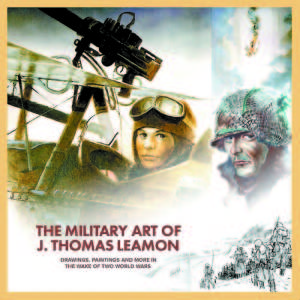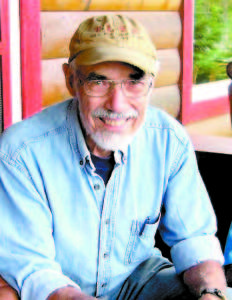War-time art reveals, heals

“The Military Art of J. Thomas Leamon: Drawings, Paintings and More in the Wake of Two World Warsâ€
 Copies of the book are available by ordering Online through the website, www.jamesleamon.com/tomsart. Also, people can special order the book at Bridgton Books.
By Dawn De Busk
Staff Writer
CASCO — J. Thomas Leamon refused to crumble under the horrors of World War II.
Instead, he built an arsenal of art.
Tom Leamon captured the real-life images of war — even while serving as an infantryman in the deplorable conditions that were present in the Battle of the Bulge during the winter of 1944/45. As part of the 75th Infantry Division of the U.S. Army, his first battle to stop the German advancement occurred on Christmas Day.
Tom Leamon’s art netted the terror and emotions of being a soldier — killing the enemy and watching comrades die. His sketches captured the extreme fatigue, the daily gruel of life in a foxhole, the uncertainty of life during wartime, and even the insanity of shell shock on the battlefield.
On the other hand, humor emerged in illustrations on the envelopes of letters he sent home during training and while recuperating from frostbite in various hospitals.
Tom Leamon’s artistic work became prolific, continuing long after he returned home from the war.
His artwork encompassed many genres: Three dimensional pieces, iconic shrines for war heroes, paintings, half-humorous greeting cards, and detailed model war airplanes started with store-bought kits and expanded upon through research and exacting details.

“This is much more than just a bunch of war pictures. There is intellectual content in his art. My feeling is that this is a special presentation inside the mind of the artist as revealed in his art.†— Jim Leamon, author, “The Military Art of J. Thomas Leamonâ€
His brother Jim Leamon felt that Tom’s art should be shared with others.
As a former professor of history and a published author, the Casco resident decided to compile a book showing his brother’s art.
“There was no definitive time that it had been on my mind. It had been a growing conviction of mine that as Tom grew older and older, I did not feel that he was getting the recognition he deserved for his skills,†Jim Leamon said.
“I thought I could do something to publicize his work,†he said.
“This is much more than just a bunch of war pictures. There is intellectual content in his art,†Jim said.
“My feeling is that this is a special presentation inside the mind of the artist as revealed in his art,†he said.
Tom’s pieces of art include an “element of the irony of war, the pathos of war, and the nobility of war that is involved in death and destruction.â€
“If you were to ask me, I think this is his manifestation of his response posttraumatic stress disorder,†he said.
“This is his venting in his mind and his soul,†he said.
Tom Leamon’s art conveys images from the war in which he served, but also includes pieces that delve into the war before that, World War I.
His older brother Tom was born in 1925. That put him at the perfect age to join the army after high school — as many young men his age did.
During his high school years, Tom had already been singled out for his artistic skills. The same rang true when he joined the Army. Soon, he was doing the lettering on helmets and the numbering on Army vehicles. He designed a handgun manual and other visual aids, Jim explained in the book.
Tom’s experience during Battle of the Bulge — cold winter temperatures and improper gear — cost him his toe. His big toe was amputated. To this day, when the weather is humid or damp, Tom’s fingers still ache. But the frostbite never stopped him from holding a pen, even during the months that he spent recovering in Army hospitals.
After the war ended, Tom earned a degree in design and freelanced as a commercial illustrator. Later, he pursued another career choice. Following in his father’s footsteps, Tom studied theology and became a minister. All the while, he poured himself into art with a military theme.
“None of this was painted by him to be published. Even as a minister, he continued his war art on the side,†Jim Leamon said.
“It was a way of helping to recover himself, and to be a service to humanity,†Jim said.
Originally — once he decided to put together the book, Jim photographed the sketches and paintings and model airplanes. His compilation did not quite click on the visual level, he said.
He credited Rene Damen, who owns Damen Digital in Casco, with fine-tuning the book. Damen actually travelled to Whately, Mass., where Tom lives, and painstakingly photographed each piece with a high-resolution camera. Damen also saw the power of the eyes in some of the paintings, and used in-set photos to draw the reader’s attention to that detail.
There was a lot of collaboration involved
“No one produces a single book themselves,†Jim said.
“Marianne is Tom’s wife. She assisted him by pulling out his mind-boggling amount of art,†he said.
She helped him locate worthwhile pieces in his studio that took up almost the entire cellar, he said.
Jim’s wife, Nicci, acted as editor and provided technical advice.
To this day, Jim visits Tom in Whately several times a year, and they talk on the phone frequently.
“He has an incredible sense of humor,†Jim said.
“When I am down there, I drive to the Post Office for his mail. He writes a little note for the post office clerk. He cannot just write, ‘This is to authorize…’ He always has to draw something funny,†he said.
As young boys listening to their father’s Sunday sermon in church, Tom’s humor emerged. A woman in the pew ahead of them removed her fox stole during the service. Upon the back of the pew, a tiny fox face stared at the boys. Tom began scribbling on a piece of paper. He hung it from the fur accessory. It said, “Do not feed the animal,†and it sent laughter throughout the church.
That same humor is interlaced in some of his military art.
In the book, The Military Art of J. Thomas Leamon, Jim wrote, “Almost seventy years have passed since the end of World War II, and yet for Tom and his fellow veterans of that conflict, the memories remain sharp and traumatic.â€
“Every ‘Merry’ Christmas season brings flash-backs of when Tom first went into action, and that time of year brings snow and cold along with stiffness and pain to hands and feet once frozen and black,†he wrote on pages 24 and 25.
“But Tom’s sense of humor and his art have helped to ease the trauma of the season with greetings to veteran comrades that help to reduce the hurt with humor,†Jim wrote.

